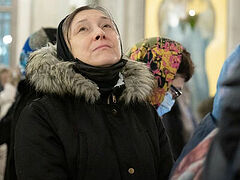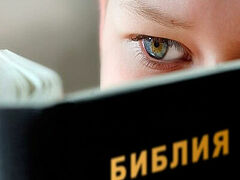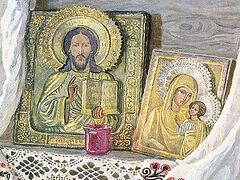My mother’s bread! Now you can’t get such bread anywhere... Times have changed, and many don’t know the value of bread. They don’t know it because they have never been hungry. In the years of my childhood bread, milk and potatoes were the main foods—and how delicious they were!
For some reason I can’t remember what bread from the store was like. It must have been like a brick. But I do remember not only the look, but even the smell of my mother’s bread: ruddy, round, tall, with a springy spongy crumb. This is how the bread of my childhood was imprinted on my memory.
Then there was no gas in houses, and bread was baked in Russian stoves.1 It’s a pity that stoves gradually disappeared from our homes. And they were used for everything: baking bread, simmering porridge in a cast-iron pot, and drying wet shoes and clothes. In case of a cold in winter, we were always put to sleep on the warm stove bed—and by the morning the illness would be gone!
Bread baking day was a special occasion for us children. Before kneading the dough, my mother would put on an apron. Even in her old age, whenever she was busy in the kitchen she always wore it. I could say that she would put on a headscarf, but in those days married village women always wore headscarves. I think she would change from a street headscarf into a light-colored household one. For some reason I don’t remember this point. I just remember her in a white headscarf.
We had our own flour and yeast and we didn’t buy them. Flour was ground from grain at a mill in a neighboring village. Yeast was made from hops—a climbing plant with flowers in the form of white fluffy cones, which we picked ourselves.
We would start with an easy task—to sieve the flour. We little children helped our mother with this. It did not seem like hard work, but by the time you’ve sieved through two buckets of flour, your arm muscles ache. Then mother would add the leaven to the water and flour in a huge four-bucket pan. It was a hard job to knead such a quantity of dough! We punched down the dough twice, then kneaded it tightly and waited for it to rise.
While the stove was still too hot to bake bread, my mother fried sour pancakes in a skillet. The bread dough was diluted with milk or water to the consistency of sour cream, and thus we had dough for pancakes. They were fried on one side, and baked with round brown blobs on the other. We ate them while they were hot, dipping them into melted yellow butter in an iron bowl.
Towards the evening, when the dough was rising, we would remove the remains of the coals from the stove and start putting the dough into pans. The loaves were of different sizes precisely because of the baking pans. Here ten-liter marmalade cans and old saucepans without handles came in handy.
Our mother baked nine loaves at a time. This bread was enough for our family of eight children for a whole week. And there was no more space for any loaves in the stove. First, my mother put large pans inside, then smaller ones, and the smallest dishes on the edge, where there was less heat. Before closing the stove door, she placed a cast-iron pot of porridge or potatoes in milk into the stove with a stove fork. Oh, if only we could have those potatoes today!
Two hours later, before taking out the bread, the oilcloth on the large table was covered with a special piece of cloth. Our mother took out the aromatic round loaves and immediately shook them out of the baking pans onto the table. She precisely shook them out, since the marmalade pans were ribbed and it was impossible to take them out easily. The bread was put onto the table with the hard upper crust down to prevent it from sinking and covered on top with another piece of cloth until it had cooled down. What a spirit reigned in the house when our mother took out the bread! The whole house was filled with a smell of the most delicious bread in the world. On the next morning the bread was put into the bottom drawer of the cupboard. It was laid sideways. We used to say: “If there is bread in the cupboard, there is food!”
We loved the little loaves—they had more crust. How delicious those crusts were! And the tastiest food for us children was a piece of freshly baked bread, covered with sour cream and sprinkled with sugar. Nothing tasted better! I would cut off a piece, run outside, and before I had time to say “Forty-one—I eat alone”, I had to share with others. Everything was fair. No one even thought of eating a piece on the sly...
I recently visited my birthplace. There in my presence my father’s elderly cousin took out loaves of bread from a stove. From a genuine Russian stove! I couldn’t resist asking her to give me a loaf to take home. This is what I call bread! As my grandson said, this bread tastes better than pastry!





